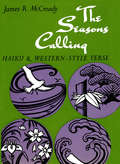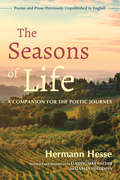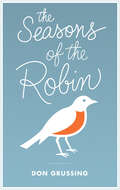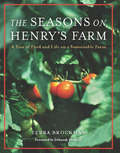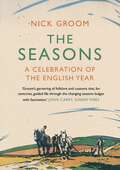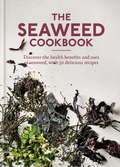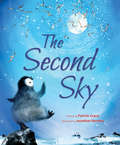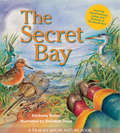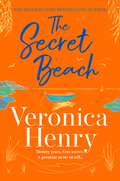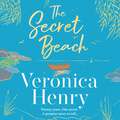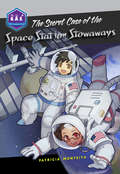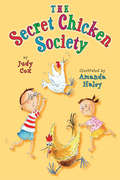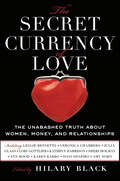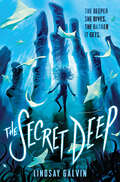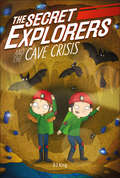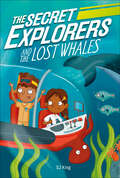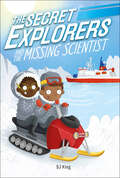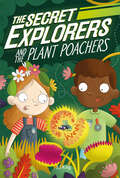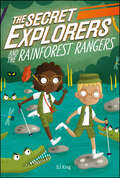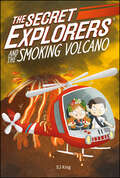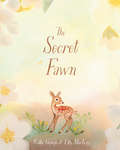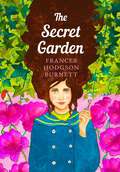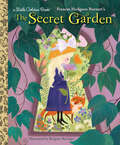- Table View
- List View
The Seasons Calling: Haiku & Western-Style Verse
by James R. Mccready Wakana KozawaThis collection of haiku and Western-style verse by an American living in Japan brings a special poetic vision to the endless cycle of life, and to its separate rhythmic movements. <P><P>Readers will find again and again in these pages the sharpened sensibility and clear observation developed by the haiku discipline.One of the aims of this book, according to its author, is to reveal the similarities between haiku and Western-style verse. Its undeniable achievement is a rediscovery of the universals of emotion and expression uniting all people. In Haiku style, though not always in haiku form, these poems invite the reader to a poignant perception of identity in apparently unrelated things and people--a Westerner falling in love or out of love with Japan; a country girl dazzled by Ginza's bright lights; a sleeper wakened by "all-night thunder," wondering "who can dream of the old days with, such violence"; a wanderer among the tombstones of Tokyo or a New England cemetery. And readers will find again in these pages the sharpened sensibility and clear observation developed by haiku discipline.
The Seasons of Arnold's Apple Tree
by Gail GibbonsThis book about nature and the changing seasons focuses on a young boy and a very special apple tree. In Gail Gibbons's bright illustrations, Arnold collects apple blossoms in spring, builds a tree house in summer, makes apple pie and cider in the fall, and hangs strings of popcorn and berries for the birds in winter, among other seasonal activities. Includes a recipe for apple pie and a description of how an apple cider press works.
The Seasons of Life: A Companion for the Poetic Journey--Poems and Prose Previously Unpublished in English
by Hermann HesseA never-before-seen volume of poetry by the preeminent poet laureate Herman Hesse--a beautiful companion to Seasons of the Soul and the author's better-known prose work.Organized into four parts--spring, summer, autumn, and winter--The Seasons of Life relates the transitions in nature to the organic progressions of human life from birth through death. From the mundane to the sublime, the spiritual to the political, and private feeling to expressed opinion, Hesse touches on the range of human experience, inviting the reader to consider both the beauty and what Hesse called the "adversities of life."Beloved by readers as a wise and open friend, Hesse offers in this never-before-translated volume an honest portrayal of a whole life: its lessons and mysteries, its glories and despairs. The poet's voice--so treasured in his novels among a worldwide English-speaking audience--can now be enjoyed through this new translation in the follow-up to Seasons of the Soul.
The Seasons of the Robin (Mildred Wyatt-Wold Series in Ornithology)
by Don GrussingIn a small nest in a large oak tree, the drama begins. A young American Robin breaks open his shell and emerges into a world that will provide the warmth of sunny days and the life-threatening chill of cold, rainy nights; the satisfaction of a full stomach and the danger of sudden predator attacks; and the chance to mature into an adult robin who’ll begin the cycle of life all over again come next spring. In The Seasons of the Robin, Don Grussing tells the uncommon life story of one of the most common birds, the North American Robin. Written as fiction to capture the high drama that goes on unnoticed right outside our windows, the book follows a young male robin through the first year of life. From his perspective, we experience many common episodes of a bird’s life—struggling to get out of the egg; awkwardly attempting to master flight; learning to avoid predators; migrating for the first time; returning home; establishing a territory; finding a mate; and beginning the cycle again. This creative approach of presenting natural history through a fictional, yet factually based, story allows us to experience the spine-tingling, nerve-wracking, adrenaline-flowing excitement that is so much a part of the life of every wild thing. As Don Grussing concludes in his preface, “Once you experience the world through a robin’s eyes, I hope you’ll look at every wild thing with new appreciation and respect for what they accomplish by living.”
The Seasons on Henry's Farm: A Year of Food and Life on a Sustainable Farm
by Terra Brockman&“[A] lyrical portrait of a central Illinois sustainable farm . . . Brockman covers her subject with hard-earned expertise and organic passion.&” —Publishers Weekly Henry&’s Farm, run by Henry Brockman, is in central Illinois—some of the richest farming land in the world. There, he and his family—five generations of farmers, including sister Terra, the author—have bucked the traditional agribusiness conventional wisdom by farming in a way that&’s sensible, sustainable, and focused on producing healthy, nutritious food in ways that don&’t despoil the land. Terra Brockman tells the story of her family and their life on the farm in the form of a year-long memoir (with recipes) that takes readers through each season. Studded with vignettes, digressions, photographs, family stories, and illustrations of the farm&’s vivid plant life, the book is a one-of-a-kind treasure that will appeal to readers of Michael Pollan, E. B. White, Gretel Ehrlich, and Sandra Steingraber. &“Here&’s what you get when the farmer&’s sister turns out to be a masterful writer: a compelling argument for rebuilding our nation&’s food security that is threaded within a lyrical, funny, suspenseful narrative of life on her brother&’s Illinois farm.&” —Sandra Steingraber, author of Having Faith &“Terra Brockman's new book is such a delightful synergy of poetic inspiration and realistic descriptions of life on a farm. Here is everything from the joy and satisfaction of growing garlic and raising turkeys, to tending fruit trees and growing vegetables . . . Given the recent renewed interest in gardening and urban farming, the appearance of this inspiring book could not be more timely.&” —Frederick Kirschenmann, president, Stone Barns Center for Food and Agriculture
The Seasons: An Elegy for the Passing of the Year
by Nick GroomFor millennia, the passing seasons and their rhythms have marked our progress through the year. But what do they mean to us now that we lead increasingly atomized and urban lives and our weather becomes ever more unpredictable or extreme? Will it matter if we no longer hear, even notice, the first cuckoo call of spring or rejoice in the mellow fruits of harvest festival? How much will we lose if we can no longer find either refuge or reassurance in the greater natural—and meteorological—scheme of things? Nick Groom's splendidly rich and encyclopedic book is an unabashed celebration of the English seasons and the trove of strange folklore and often stranger fact they have accumulated over the centuries. Each season and its particular history are given their full due, and these chapters are interwoven with others on the calendar and how the year and months have come to be measured, on important dates and festivals such as Easter, May Day and, of course, Christmas, on that defining first cuckoo call, on national attitudes to weather, our seasonal relationship with the land and horticulture and much more. The author expresses the hope that his book will not prove an elegy: only time will tell.
The Seaweed Cookbook: Discover the health benefits and uses of seaweed, with 50 delicious recipes
by AsterWhile seaweed remains a core culinary ingredient in Asia, these traditions are enjoying a resurgence across the world, from California to Cornwall, Norway, Sweden and Denmark.Seaweed is one of nature's healthiest foods. Rich in vitamin B12, it is particularly good for vegans as this vitamin is usually found in animal sources. It also contains iodine, which helps promote a healthy metabolism.A little seaweed goes a long way and so it is perfect as a seasoning, whether in salt or infused in oils and dressings. It can be used to flavour both sweet and savoury, from broths, salads and stews to scones, shortbread, chocolate and granola. And because it is so good for our skin, there will also be recipes for body scrubs, seaweed soaks and masks.
The Seaweed Cookbook: Discover the health benefits and uses of seaweed, with 50 delicious recipes
by AsterWhile seaweed remains a core culinary ingredient in Asia, these traditions are enjoying a resurgence across the world, from California to Cornwall, Norway, Sweden and Denmark.Seaweed is one of nature's healthiest foods. Rich in vitamin B12, it is particularly good for vegans as this vitamin is usually found in animal sources. It also contains iodine, which helps promote a healthy metabolism.A little seaweed goes a long way and so it is perfect as a seasoning, whether in salt or infused in oils and dressings. It can be used to flavour both sweet and savoury, from broths, salads and stews to scones, shortbread, chocolate and granola. And because it is so good for our skin, there will also be recipes for body scrubs, seaweed soaks and masks.
The Second Sky
by Patrick GuestAn inspiring story about finding your true elementEver since he first hatched, Gilbert has wanted to fly. But with his big, clumsy feet and small, fluffy wings, learning to fly is a bigger challenge than Gilbert anticipated. His fellow penguins tell him to give up, but Gilbert is sure that if he keeps trying, he&’ll be able to soar…Young readers will fall in love with this sweet, motivating story about overcoming obstacles and discovering your hidden talents.
The Secret Bay (Tilbury House Nature Book)
by Rebekah Raye Kimberly Ridley<P><P>AWARDS: *Moonbeam Silver*, *John Burroughs Association Riverby 2016 Award* <P><P> Estuaries form where river meets sea and fresh water mixes with salt. Teeming with life, these places of salt marshes, mudflats, and tidal backwaters serve as nursery areas for oceangoing fish, migratory stopovers for shorebirds, and homes for an amazing diversity of snails, bivalves, fish, mammals, horseshoe crabs, fiddler and blue crabs, terrapin turtles, plankton, and many others, all of whom we meet in the pages of this delightful book. <P><P> Narrated in the poetic voice of the estuary itself, and accompanied by natural-history sidebars about estuary plants, animals, and cycles, THE SECRET BAY is another topnotch nature book from the author and illustrator of the award-winning, bestselling The Secret Pool. <P><P> A stand-alone book and a stunning companion volume to Ridley and Raye’s award-winning Secret Pool. Ridley deftly augments the estuary’s lyrical narrative voice with sidebars about the plants, animals, and natural processes of an estuary. Raye’s gorgeous watercolors reveal new features and hidden treats with each reading. Back matter includes The Estuary Food Web, Great Escapes (how estuary animals avoid predators), and an author’s note about the challenges facing estuaries. A perfect book for the budding naturalist and for his or her parents and teachers. <P><P> Fountas & Pinnell Level S Lexile 1180
The Secret Beach: The stunning, escapist and gorgeously romantic new novel from the Sunday Times bestselling author
by Veronica HenryTHE STUNNING AND ROMANTIC NEW NOVEL FROM SUNDAY TIMES BESTSELLING AUTHOR VERONICA HENRY!'Dreamy and irresistible!' JILL MANSELL'A summery tale of intrigue, family drama and romance. I loved it!' SARAH MORGANTwenty years.One secret.A promise never to tell...Nikki finally owns the little coastguard cottage of her dreams - and it's a few steps away from the hidden beach that means so much to her.But when a handwritten note lands on her doorstep, she realises it's only a matter of time before the heartbreaking truth of her past is uncovered.Twenty years ago, her whole world was turned upside-down when a terrible storm rolled into the small seaside town of Speedwell.Ever since that night, Nikki has been keeping a secret. One she knows has the potential to destroy the lives of those she loves most.Because as sure as the tide turns, there are no secrets in a small town...Your favourite authors love The Secret Beach:'What an amazing book! Veronica always delivers a cracking read, but this is exceptional' MILLY JOHNSON'Family secrets, a beautiful Cornish setting and a beach like no other... I was swept away!' LUCY DIAMOND'Captivating and romantic. I completely fell in love with Speedwell' HEIDI SWAIN'A wonderful treat of a read!' SUE MOORCROFT'A story filled with so much heart. Simply gorgeous!' LIZ FENWICK'Warm, wise, and completely wonderful. I now want to move to Speedwell immediately' ALEX BROWN
The Secret Beach: The stunning, escapist and gorgeously romantic new novel from the Sunday Times bestselling author
by Veronica HenryTHE STUNNING AND ROMANTIC NEW NOVEL FROM SUNDAY TIMES BESTSELLING AUTHOR VERONICA HENRY!'Dreamy and irresistible!' JILL MANSELL'A summery tale of intrigue, family drama and romance. I loved it!' SARAH MORGANTwenty years.One secret.A promise never to tell...Nikki finally owns the little coastguard cottage of her dreams - and it's a few steps away from the hidden beach that means so much to her.But when a handwritten note lands on her doorstep, she realises it's only a matter of time before the heartbreaking truth of her past is uncovered.Twenty years ago, her whole world was turned upside-down when a terrible storm rolled into the small seaside town of Speedwell.Ever since that night, Nikki has been keeping a secret. One she knows has the potential to destroy the lives of those she loves most.Because as sure as the tide turns, there are no secrets in a small town...Your favourite authors love The Secret Beach:'What an amazing book! Veronica always delivers a cracking read, but this is exceptional' MILLY JOHNSON'Family secrets, a beautiful Cornish setting and a beach like no other... I was swept away!' LUCY DIAMOND'Captivating and romantic. I completely fell in love with Speedwell' HEIDI SWAIN'A wonderful treat of a read!' SUE MOORCROFT'A story filled with so much heart. Simply gorgeous!' LIZ FENWICK'Warm, wise, and completely wonderful. I now want to move to Speedwell immediately' ALEX BROWN
The Secret Case of the Space Station Stowaways (Galactic Academy of Science)
by Pat MonteithMae and Clinton's teenage mentor from the future, Selectra Volt, can only give them vague hints about what will occur. Their time travel takes them to visit space historian Steven Dick, ancient Chinese admiral Zheng He, Isaac Newton, Wernher von Braun, astronaut Sunita Williams, space sickness scholar Suzanne Nooij, and astronaut and asteroid scholar Ed Lu. When they learn that the malicious Dr. Gravitium is hunting asteroids, they have to come up with a plan and visit the space station to try and stop him before he destroys one, or maybe two, worlds.
The Secret Chicken Society
by Judy Cox Amanda HaleyWhen Daniel finds out that his class is going to hatch chicks as a science project, he is thrilled. He's sure that his parents will let him adopt Peepers, who is his favorite. But who ever guessed that chicks could run amok and get into so much trouble?! This warmhearted chapter book about an environmentally-conscious family's experiment with poultry farming will provide plenty of clucks and lots of chuckles for young readers.
The Secret Currency of Love: The Unabashed Truth About Women, Money, and Relationships
by Hilary Black“Sex & The City meets The Wall Street Journal....Juicy, smart, dramatic and insightful—an addictive read.”—Beth Kobliner, author of Get a Financial Life: Personal Finance in Your Twenties and ThirtiesIn The Secret Currency of Love, edited by Hilary Black, acclaimed, bestselling, and award-winning women writers explore the fraught and powerful connections between love and money. As featured on the "Today Show"--with contributions by Karen Karbo, Kathryn Harrison, Lori Gottlieb, Julia Glass, Rebecca Traister, Dani Shapiro, Amy Sohn, and others--The Secret Currency of Love takes an unabashed look at relationships through the often-distorting lens of finance. As Elle magazine informs us, “All the bases are covered here, from the hard lessons women learn (and impart) to the inextricability of romance and cold hard cash.”
The Secret Deep
by Lindsay GalvinWhen Aster wakes alone, stranded, on a tropical island, she has no idea what has happened, why she is there, or where to find her younger sister, Poppy. The answers lie in the secretive underwater world surrounding the desert island, populated by the beautiful and the unexpected...Aster's last memories are blurred. All she can remember is being on a boat with her aunt and other members of the eco-village where she was sent to live after the death of her mother. But Sam, who once met the sisters on a plane, makes links between the mystery of their disappearance and suspicious happenings in his own life. Though Aster can't think clearly, she feels the answers to all of her questions may lie beneath the sea. But nothing can prepare her for the secrets and revelations that she will uncover in her search for her sister.In a stunning dual narrative, the truth unravels with devastating effect -- and the answer lies in the secret underwater world surrounding the desert island. The more Aster searches for Poppy, the more strange things she finds. There is a secret deep in the water. A secret with the potential to change medical history.
The Secret Explorers and the Cave Crisis (The Secret Explorers)
by SJ KingLearn all about life in the desert with this nature-themed installment of DK&’s educational fiction series for children aged 7 to 9 years old.Meet the Secret Explorers - a band of brainiac kids from all around the world, here to take young readers on a series of fact-filled fictional adventures! Each with their own specialty, from outer space to dinosaurs, these young globetrotters will teach kids aged 7-9 that learning can be fun, encouraging them to become experts in something they love. In this story, Leah the biology explorer and Cheng the geology expert are sent on a daring mission to a network of caves in India. However, when they get there they realize there&’s more to this mission than meets the eye. The gripping narrative is filled with scientific facts as the explorers navigate the subterranean world and come across the animals that live there.This epic adventure is packed with: - Fun facts and beautiful subterranean illustrations for kids aged 7-9.- Informative diagrams to make science and nature seem simple.- A summary of all the scientific discoveries made throughout the story.- Quizzes, mission notes, and a glossary of definitions making it the perfect classroom read.Let&’s explore! The Secret Explorers and the Cave Crisis by SJ King is the perfect gift for children who are interested in all things nature, with information about geology and animals that will stretch the wildest of imaginations. Never miss a mission! A total of 12 different books, The Secret Explorer series is both educational and imaginative, combining exciting stories with real-life facts.Embark on a space mission adventure in The Secret Explorers and the Comet Collision. Travel back in time to save a dinosaur egg from destruction in The Secret Explorers and the Jurassic Rescue. Take part in a volcano rescue in The Secret Explorers and the Smoking Volcano. Then travel to the Arctic for a rescue mission in Secret Explorers and the Missing Scientist.Whatever your preferred topic, there&’s a mission waiting for you!
The Secret Explorers and the Lost Whales (The Secret Explorers)
by SJ KingDive into the world of The Secret Explorers and learn about ocean life in this action-packed first installment in a brand-new fiction series.Meet The Secret Explorers! This group of brilliant kids comes together from all four corners of the globe to fix problems, solve mysteries, and gather knowledge all over the planet - and beyond. Whenever their help is needed, a special sign will appear on a door. They step through to the Exploration Station and receive their mission...In The Lost Whales, marine life expert Connor needs to use his underwater expertise to help save a pod of humpback whales that have lost their way. Along with space expert Roshni, he sets out in a submarine to search for a way to steer the whales back on track, but encounters unexpected problems along the way, including lost baby whales and a fleet of boats. Will The Secret Explorers manage to succeed in their mission?Packed with fun illustrations and facts about humpback whales, marine life, and how climate change is affecting the oceans, this thrilling adventure is perfect for emerging readers. The action-packed narrative keeps kids engaged and makes learning about the natural world fun.
The Secret Explorers and the Missing Scientist (The Secret Explorers)
by SJ KingMeet the Secret Explorers! Children will be inspired to discover the world with these character-driven adventure stories for children aged 7 to 9 years old.Learn all about polar expeditions and the Arctic in this climate-related installment of DK Books' new educational fiction series for children.Meet the Secret Explorers - a band of brainiac kids from all around the world. Everyone in this diverse group of young experts has a speciality, from outer space to dinosaurs, and each story follows a character who gets chosen for a "secret exploration".In this fun, fact-filled children's book, engineering expert Kiki and Connor the marine biologist are sent on a mission to the Arctic. There they discover a research vessel studying the effects of climate change that has become trapped in the sea ice.To make matters worse, one of the ship's scientists who went to find help at a nearby research station hasn't returned. It's up to the Secret Explorers to find the scientist, free the ship, and save the day! Kids will love turning the pages to find out if the Secret Explorers manage to succeed in their mission!Enter the frozen world...With a thrilling narrative that keeps kids engaged, The Secret Explorers and the Missing Scientist book by SJ King is the perfect gift for children who are into all things arctic. It's written for children aged 7-9 years, with lots of information on the arctic world and the effects of melting sea ice.At the end of the book, you'll find "Kiki's Mission Notes" which is a summary of all the scientific facts and discoveries made throughout the story. With fun illustrations, quizzes, and a vocabulary list, the educational value of this book is outstanding and great for a classroom read!Get Ready to join the Secret Explorers ClubThe Secret Explorers series is a reminder to kids that they are limited only by their imagination and teaches them that learning is fun! But most of all, these educational books encourage children to believe that they can become experts in something they love.This edge-of-your-seat adventure book is packed with:• Fun facts and illustrations about polar bears• Simple and engaging explanations on how to survive in arctic conditions• Quizzes, mission notes, and a glossary of words with definitionsComplete the seriesEach book in the series combines exciting adventures with real-life facts related to the Secret Explorers' latest fictional mission.Don't miss out on more secret explorations! Take on an out-of-this-world mission in The Secret Explorers and the Comet Collision. Travel back in time to save a dinosaur egg from destruction in The Secret Explorers and the Jurassic Rescue. Set out on a journey to stop the Cairo Museum from closing down in The Secret Explorers and the Tomb Robbers. Then take a trip up an erupting volcano in The Secret Explorers and the Smoking Volcano.
The Secret Explorers and the Plant Poachers (The Secret Explorers)
by SJ KingGrab your backpack and let&’s head into the wild with the Secret Explorers! Embark on an unforgettable journey of discovering forest life and protecting an endangered plant! Learn all about the amazing Venus flytrap in this action-packed, conservation-themed installment of DK&’s new educational fiction series. Meet the Secret Explorers — a band of brainiac kids from all around the world. Everyone in this diverse group of young experts has a specialty, from the dinosaurs to volcanoes. Each story follows a character who gets chosen for a &“secret exploration.&” This edge-of-your-seat educational fiction book for kids is packed with: • Fun facts and illustrations about exciting plant species. • Simple and informative diagrams show kids all they need to know about the Venus flytrap. • Quizzes, mission notes and a glossary of words with definitions. Uncover the culprit behind the plant thefts In this fascinating children&’s nature book, we join biology expert Leah on a mission to a forest in North Carolina. Joined by history buff Gustavo, the team must work together with a botanist to protect the endangered Venus flytrap from being stolen by poachers and sold for money. It&’ll take every bit of brainpower, bravery, and expertise that Leah and Gustavo have to stop the poachers and rescue the plants. At the end of this fictional action book, you&’ll find "Leah's Mission Notes," which is a summary of all the scientific facts and discoveries made throughout the story. With a gripping narrative that keeps kids engaged, The Secret Explorers and the Plant Poachers by SJ King is the perfect gift for kids ages 7-9 captivated by nature. Packed with lots of information about different forest plants, this adventure book gives kids a thrilling introduction to the natural world. More in the series to discover Don't miss out on more secret explorations! Embark on an Arctic adventure of epic proportions in The Secret Explorers and the Missing Scientist. Discover the dramatic power of an erupting volcano in The Secret Explorers and the Smoking Volcano. Finally, set out on a journey to stop the Cairo Museum from closing down in The Secret Explorers and the Tomb Robbers.
The Secret Explorers and the Rainforest Rangers (The Secret Explorers)
by SJ KingLet your little nature-lover take a swing through the rainforest in this conservation-themed fifth installment of DK&’s new educational fiction series! Meet the Secret Explorers - a band of brainiac kids from all around the world. Everyone in this diverse group of young experts has a specialty, from outer space to dinosaurs, and each story follows a character who gets chosen for a &“secret exploration&”. This edge-of-your-seat science book for kids is packed with: • Fun facts and illustrations about animals and plants found in the rainforest of Borneo • Simple and engaging explanations on how deforestation is altering our planet's biodiversity • Quizzes, mission notes, and a glossary of words with definitions • Information that supports STEM-based curriculums Kids to the rescue!In this fact-stuffed children&’s science book, we follow rainforest expert Ollie on an exciting mission to rescue a lost baby orangutan in the steamy rainforest of Borneo. Accompanied by engineering expert Kiki, they set out in a glider to search for the friendly ape.Along the way, they encounter greedy plantation owners who are plotting to destroy the forest to expand a palm oil plantation! They also learn about the threat that endangered animals and plants face due to deforestation. Kids will love turning the pages to find out if the Secret Explorers manage to succeed in their mission!It&’s the perfect gift for children aged 7-9 who love all things rainforest. Packed with lots of information on animal and plant life, this epic adventure book gives them a thrilling introduction to nature. Keep on exploring!Each book in the series combines exciting adventures with real-life facts related to the Secret Explorers&’ latest fictional mission. Don't miss out on more secret explorations! Dive into an underwater adventure in The Secret Explorers and the Lost Whales. Travel back in time to save a dinosaur egg from destruction in The Secret Explorers and the Jurassic Rescue. Finally, set out on a journey to stop the Cairo Museum from closing down in The Secret Explorers and the Tomb Robbers.
The Secret Explorers and the Smoking Volcano (The Secret Explorers)
by SJ KingBuckle up for an explosive adventure! Discover the dramatic power of an erupting volcano in this action-packed sixth installment of DK&’s new educational fiction series! Meet the Secret Explorers - a band of brainiac kids from all around the world. Everyone in this diverse group of young experts has a specialty, from outer space to dinosaurs, and each story follows a character who gets chosen for a &“secret exploration&”. This edge-of-your-seat science book for kids is packed with: • Fun facts and illustrations about the Earth&’s tectonic plates • Simple and engaging explanations on how volcanoes are formed • Quizzes, mission notes, and a glossary of words with definitions • Information that supports a STEM-based curriculum A new adventure unfoldsIn this fun, fact-filled children&’s science book, we join volcanoes expert Cheng on an exciting mission to Mount Yasur on the island of Vanuatu. Joined by biology expert Leah, the team is beyond excited to witness a real-life volcanic eruption.But soon, excitement turns to worry when they realize that people are in danger. Working together swiftly and heroically, they must stage a rescue mission. Kids will love turning the pages to find out if the Secret Explorers manage to succeed in their mission!It&’s the perfect gift for children aged 7-9 who love all things geology. Packed with lots of information on volcanoes, this epic adventure book gives them a thrilling introduction to earth science. Don&’t let the discoveries stop Each book in the series combines exciting adventures with real-life facts related to the Secret Explorers&’ latest fictional mission. Don't miss out on more secret explorations! Dive into an underwater adventure in The Secret Explorers and the Lost Whales. Travel back in time to save a dinosaur egg from destruction in The Secret Explorers and the Jurassic Rescue. Finally, set out on a journey to stop the Cairo Museum from closing down in The Secret Explorers and the Tomb Robbers.
The Secret Fawn
by Kallie GeorgeGorgeous cut-paper art illuminates this sweet, heartfelt picture book about how special being little can be. For fans of Finding Wild and Little Fox in the Forest.A little girl is always missing out on the wonderful things her family gets to see and do, just because she is the youngest and smallest. She misses seeing shooting stars because she goes to bed too early; she can't pick the first apple of autumn because she's too short; and, this morning, everyone else got to see a deer . . . except her. She goes into her backyard in search of the deer, a sugar cube tucked in her pocket. She sees a flick of brown in the orchard -- is that the deer? No, it's just the neighbor's friendly dog (Shhhhh, Nala!). Is that it by the pond? No, that's just a bird, playing in the water. Just when she's about to give up, she spots a fawn, beautiful, quiet and small . . . just like her. The Secret Fawn beautifully captures the power of nature to inspire children and shows how connecting with animals can help kids who feel left out or overlooked.
The Secret Garden
by Frances Hodgson BurnettSisterhood Classics - classic female writers, iconic female characters, superb female designers.After losing her parents, young Mary Lennox is sent from India to live in her uncle's gloomy mansion on the wild English moors. She is lonely and has no one to play with, but one day she learns of a secret garden somewhere in the grounds that no one is allowed to enter. Then Mary uncovers an old key in a flowerbed - and a gust of magic leads her to the hidden door. Slowly she turns the key and enters a world she could never have imagined.
The Secret Garden (Little Golden Book)
by Frances Hodgson Burnett Frances GilbertA picture book retelling, perfect for the youngest readers, of the beloved classic children's story—and new movie starring Colin Firth, coming to theaters April 2020. &“A key!&” cried Mary. &“Is it the key to the secret garden?&” This story of a key that leads a lonely girl to a secret garden is a beloved children&’s classic. Based on Frances Hodgson Burnett&’s 1911 children&’s novel, this retelling, simply and warmly written, will charm young readers. They&’ll fall in love with Mary, her gentle friend Dickon, and the beautiful garden they bring to life. And the lush pictures by Brigette Barrager, illustrator of Uni the Unicorn, will let young children feel they've entered the garden themselves.
